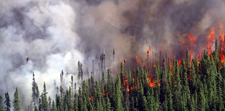Researchers: Indigenous knowledge can be key to fighting climate change
LAWRENCE — While indigenous communities have developed knowledge over centuries to manage their lands and adapt to challenges such as rising sea levels or wildfires, they are still deeply affected by climate change. Two University of Kansas professors have authored research exploring cases of indigenous communities that have had success in applying traditional knowledge to fighting climate change and how American and international law falls short in preventing exploitation of those tribes and methods.
 Joseph Brewer II, assistant professor in environmental studies, and Elizabeth Kronk Warner, professor and director of the Tribal Law and Government Center at the School of Law, have published a working paper, “Guarding Against Exploitation: Protecting Indigenous Knowledge in the Age of Climate Change.” The study shares examples of tribes that have developed knowledge in how to ameliorate drastic effects of climate change on their native lands as well as indigenous communities that have developed their own laws on ways which their traditional knowledge can be used outside of their communities.
Joseph Brewer II, assistant professor in environmental studies, and Elizabeth Kronk Warner, professor and director of the Tribal Law and Government Center at the School of Law, have published a working paper, “Guarding Against Exploitation: Protecting Indigenous Knowledge in the Age of Climate Change.” The study shares examples of tribes that have developed knowledge in how to ameliorate drastic effects of climate change on their native lands as well as indigenous communities that have developed their own laws on ways which their traditional knowledge can be used outside of their communities.
“The inspiration for this article was everyone would talk aspirationally about how we should be using traditional knowledge to help fight climate change, but none of us knew exactly how to do that,” Kronk Warner said. “Unfortunately, we came to the conclusion there really isn’t a good legal remedy in the existing categories of intellectual property law to protect traditional knowledge.”
 The authors explore several examples of traditional knowledge: One prime example is the Alaskan village Huslia, an interior community of roughly 300 residents, mostly Native Alaskan or Koyukon Athabascan, located in the boreal forest climate system. Like much of Alaska, the area has seen drastic temperature changes in the last 15 years and intense fires in the summer. Residents have long known ways to manage types of trees in the area to build buffers around the community and suppress fire by planting and culling undergrowth at certain times. That knowledge, like flood prediction methods of other Alaskan communities, could help countless people, yet the potential for someone to commercialize the knowledge without sharing the benefits is very real.
The authors explore several examples of traditional knowledge: One prime example is the Alaskan village Huslia, an interior community of roughly 300 residents, mostly Native Alaskan or Koyukon Athabascan, located in the boreal forest climate system. Like much of Alaska, the area has seen drastic temperature changes in the last 15 years and intense fires in the summer. Residents have long known ways to manage types of trees in the area to build buffers around the community and suppress fire by planting and culling undergrowth at certain times. That knowledge, like flood prediction methods of other Alaskan communities, could help countless people, yet the potential for someone to commercialize the knowledge without sharing the benefits is very real.
“Alaska is the face of climate change,” Brewer said. “Many communities don’t want to see their traditional knowledge commercialized or used in a way that can damage the tribes. There are examples of tribes that will share knowledge, but it’s paramount to honor tribal protocols first and foremost in the relationship-building process on the road to sharing knowledge.”
American intellectual property law is not effective in protecting indigenous knowledge because it tends to favor a small group of innovators or one person who developed an idea in a definable time period.
 Brewer, a citizen of the Cherokee Nation of Oklahoma, and Kronk Warner, a citizen of the Sault Ste. Marie Tribe of Chippewa Indians, argue perhaps the most effective way for native communities to both protect and share indigenous knowledge is to develop their own tribal laws governing the use of traditional knowledge as it applies to climate change. The benefits would include tribes' ability to practice sovereignty, decide how traditional knowledge can be used and ensure the community benefits from its use while helping others fight and adapt to climate change. There are challenges to enacting such laws and codes, including communities often not knowing such a method is an option, lack of funding and other community problems taking priority.
Brewer, a citizen of the Cherokee Nation of Oklahoma, and Kronk Warner, a citizen of the Sault Ste. Marie Tribe of Chippewa Indians, argue perhaps the most effective way for native communities to both protect and share indigenous knowledge is to develop their own tribal laws governing the use of traditional knowledge as it applies to climate change. The benefits would include tribes' ability to practice sovereignty, decide how traditional knowledge can be used and ensure the community benefits from its use while helping others fight and adapt to climate change. There are challenges to enacting such laws and codes, including communities often not knowing such a method is an option, lack of funding and other community problems taking priority.
Without tribal environmental laws in place, tribes are left to primarily rely on academic Institutional Review Boards to protect their interests. This is because academic researchers are often the ones who interact with indigenous communities most extensively. Researchers are often governed by Institutional Review Boards of their own universities, which can provide an ethical framework on how researchers and communities can work together, but fall short of legally preventing exploitation of traditional knowledge.
There are, however, several examples of communities that have had success. The authors point out three tribes: The Colorado River Indian Tribes, Ho-Chunk Nation and Sisseton Wahpeton Oyate have enacted laws to protect traditional knowledge while allowing for partnerships with academic researchers and sharing of valuable ideas.
“In my view, this can be a way to show policy makers that indigenous knowledge has value,” Kronk Warner said. “We have been practicing adaptation for a long time. Indigenous communities have a strong history of resiliency.”
Photo: 2005 King County Creek fire, Alaska, courtesy WikiCommons. Public domain.